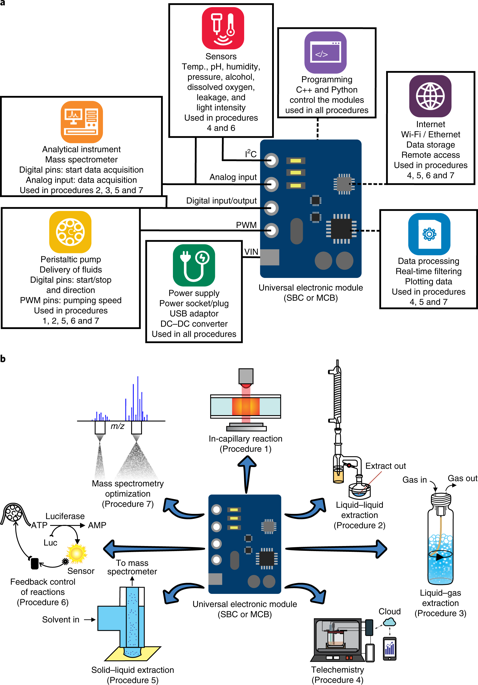当前位置:
X-MOL 学术
›
Nat. Protoc.
›
论文详情
Our official English website, www.x-mol.net, welcomes your feedback! (Note: you will need to create a separate account there.)
Facilitating chemical and biochemical experiments with electronic microcontrollers and single-board computers.
Nature Protocols ( IF 14.8 ) Pub Date : 2020-01-29 , DOI: 10.1038/s41596-019-0272-1 Gurpur Rakesh D. Prabhu , Tzu-Hsien Yang , Chun-Yao Hsu , Chun-Pei Shih , Chun-Ming Chang , Pei-Han Liao , Hsiang-Ting Ni , Pawel L. Urban
Nature Protocols ( IF 14.8 ) Pub Date : 2020-01-29 , DOI: 10.1038/s41596-019-0272-1 Gurpur Rakesh D. Prabhu , Tzu-Hsien Yang , Chun-Yao Hsu , Chun-Pei Shih , Chun-Ming Chang , Pei-Han Liao , Hsiang-Ting Ni , Pawel L. Urban

|
Since the advent of modern science, researchers have had to rely on their technical skills or the support of specialized workshops to construct analytical instruments. The notion of the 'fourth industrial revolution' promotes construction of customized systems by individuals using widely available, inexpensive electronic modules. This protocol shows how chemists and biochemists can utilize a broad range of microcontroller boards (MCBs) and single-board computers (SBCs) to improve experimental designs and address scientific questions. We provide seven example procedures for laboratory routines that can be expedited by implementing this technology: (i) injection of microliter-volume liquid plugs into microscale capillaries for low-volume assays; (ii) transfer of liquid extract to a mass spectrometer; (iii) liquid-gas extraction of volatile organic compounds (called 'fizzy extraction'), followed by mass spectrometric detection; (iv) monitoring of experimental conditions over the Internet cloud in real time; (v) transfer of analytes to a mass spectrometer via a liquid microjunction interface, data acquisition, and data deposition into the Internet cloud; (vi) feedback control of a biochemical reaction; and (vii) optimization of sample flow rate in direct-infusion mass spectrometry. The protocol constitutes a primer for chemists and biochemists who would like to take advantage of MCBs and SBCs in daily experimentation. It is assumed that the readers have not attended any courses related to electronics or programming. Using the instructions provided in this protocol and the cited material, readers should be able to assemble simple systems to facilitate various procedures performed in chemical and biochemical laboratories in 1-2 d.
中文翻译:

利用电子微控制器和单板计算机促进化学和生化实验。
自从现代科学问世以来,研究人员不得不依靠他们的技术技能或专门研讨会的支持来构建分析仪器。“第四次工业革命”的概念促使个人使用广泛使用的廉价电子模块来构建定制系统。该协议说明化学家和生物化学家如何利用各种微控制器板(MCB)和单板计算机(SBC)改进实验设计并解决科学问题。我们提供了七个例程的示例程序,可以通过实施该技术来加快实验室程序:(i)将微升体积的液体塞注入微型毛细管中以进行小体积分析;(ii)将液体提取物转移到质谱仪上;(iii)液-气萃取挥发性有机化合物(称为“泡沫萃取”),然后进行质谱检测;(iv)实时监控互联网云上的实验条件;(v)通过液体微结界面将分析物转移到质谱仪,进行数据采集,并将数据沉积到互联网云中;(vi)生化反应的反馈控制;(vii)优化直接注入质谱法中的样品流速。该方案为希望在日常实验中利用MCB和SBC的化学家和生物化学家提供了入门。假定读者没有参加任何与电子学或编程有关的课程。使用本协议中提供的说明和引用的材料,
更新日期:2020-01-29
中文翻译:

利用电子微控制器和单板计算机促进化学和生化实验。
自从现代科学问世以来,研究人员不得不依靠他们的技术技能或专门研讨会的支持来构建分析仪器。“第四次工业革命”的概念促使个人使用广泛使用的廉价电子模块来构建定制系统。该协议说明化学家和生物化学家如何利用各种微控制器板(MCB)和单板计算机(SBC)改进实验设计并解决科学问题。我们提供了七个例程的示例程序,可以通过实施该技术来加快实验室程序:(i)将微升体积的液体塞注入微型毛细管中以进行小体积分析;(ii)将液体提取物转移到质谱仪上;(iii)液-气萃取挥发性有机化合物(称为“泡沫萃取”),然后进行质谱检测;(iv)实时监控互联网云上的实验条件;(v)通过液体微结界面将分析物转移到质谱仪,进行数据采集,并将数据沉积到互联网云中;(vi)生化反应的反馈控制;(vii)优化直接注入质谱法中的样品流速。该方案为希望在日常实验中利用MCB和SBC的化学家和生物化学家提供了入门。假定读者没有参加任何与电子学或编程有关的课程。使用本协议中提供的说明和引用的材料,


























 京公网安备 11010802027423号
京公网安备 11010802027423号